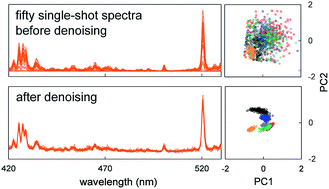Chemometric sorting based on laser-induced plume fluorescence: characterization of spectral noise for effective preprocessing†
Abstract
We previously demonstrated a sensitive technique for material analysis based on laser-induced plume fluorescence. It is ideal for minimally destructive multi-element analysis such as the authentication of artwork and documents. In the present study, we focus on spectral denoising. We find that the denoising methods used in laser-induced breakdown spectroscopy cannot be copied directly. This is because the mechanism of plume fluorescence is fundamentally different from plasma emissions. We propose a two-step spectral preprocessing scheme. Step 1 is the rejection of dim spectra from the data set. These dim spectra are unique to minimally destructive analysis. Step 2 is the normalization of the spectral area to a constant, but unlike breakdown spectroscopy, normalization must be preceded by mean subtraction else wobbly baselines affect the spectral areas. We show that this normalization step is very effective in reducing intensity fluctuations. This is because fluorescence, unlike breakdown emissions, is a linear process. We apply the scheme to the fluorescence spectra of plumes of red seal inks. We reduce the single-shot signal uncertainty from 54% to 6.5% and demonstrate clean sorting of inks based on unsupervised principal component analysis of single-shot spectra.



 Please wait while we load your content...
Please wait while we load your content...